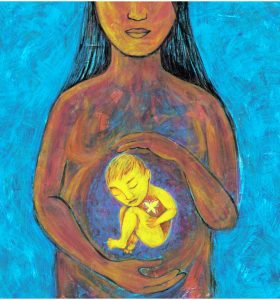A Woman’s Perspective: Pregnancy, Month by Month

Here are a few month-by-month pregnancy observations and tips for moms-to-be.
Month one
Technically the first month of pregnancy is defined up to the fourth week of pregnancy. Early signs of pregnancy differ from person to person — but a positive pregnancy test and a missed period usually confirm you are a mom-to-be. Prenatal care providers will date your pregnancy from the first day of your last period, but you are not actually pregnant for those first two weeks because you conceived usually 12 to 14 days before the first day of your period (tricky as this is backward), and this can also be (in a typical 28- to 30-day cycle) around days 12 to 14 after the first day of your period. What’s happening in your body during month one? Egg and sperm meet in the fallopian tube and travel into the uterus. The embryo burrows into the uterine wall around 10 days after conception. Prenatal blood work is usually recommended in your first month of pregnancy.
The most sensitive early pregnancy sign is that your resting heart rate goes up about 10 to 15 beats per minute — so for those of you tracking with Fitbits or the like, this is a sensitive early indicator.
Month two
During your second month of pregnancy, your baby goes from blastocyst to zygote — a dividing ball of cells taking on a more human form. Changes you might experience in your second month of pregnancy include some nausea, vomiting, food aversion and sensitivity, and fatigue. Exercising can help these feelings. (Remember, it is all about perceived exertion, not heart rate since each of us has different ranges of heart rate in exercise.)
Month three
Your body is continuing to adjust to its shifting hormone levels. Changes you might experience in your third month of pregnancy include a decrease in nausea (for some women nausea exists throughout their pregnancy), and an extra 2 percent of body fat between your middle and top of thighs. (If you keep exercising, this extra fat will eventually be gone at the end of your pregnancy.) You might also start to see that the widening of your middle as your uterus grows to the size of a grapefruit.
Month four
Your body’s hormones are more stabilized in the fourth month of pregnancy — and you are probably feeling less moody. Your energy level usually increases around this month as well. Changes you might experience now include feeling the first flutters of your baby’s movement (called “quickening”). Your sex drive may also return. Outward signs of pregnancy may begin to appear.
Month five
Halfway through your pregnancy, the changes you might experience include an increase in appetite, and a return of ongoing fatigue. Some women experience forgetfulness, sometimes called “pregnancy brain.” You may begin to feel your baby move more now. Stand and move often, as your circulation is changing.
Month six
Your baby is increasingly making his or her presence known by now. Changes you might experience include the skin on your stomach feeling itchy as it stretches around your growing womb. You might also experience bleeding gums, constipation, and heartburn. Leg cramps may intensify. You’ll gain between a half-a-pound and a pound a week at this time. The increased weight may result in varicose veins or hemorrhoids.
Month seven
If you have not already done so, it is time to plan your maternity leave and make birth plans. Changes you might experience this month include cramping in your hands and feet. Mood swings and increased irritability are common now, too. You may experience more movement of your baby. Your joints may feel looser. Many women also experience Braxton Hicks contractions (non-productive contractions).
Month eight
Your baby will usually grow rapidly during the eighth month, and you will gain about a pound per week. Changes you might experience now include difficulty sleeping as your baby pushes on your rib cage and organs. Pelvic pressure may increase as the baby drops into this area. Indigestion and heartburn may become more intense. There may also be an increase in the frequency of urination, backaches, and anxiety. Skin continues stretching and stretch marks may appear. Braxton Hicks contractions become more regular.
Month nine
The last month brings changes such as being able to breathe easier as your baby settles into the pelvis (this is known as lightening). Sleep may become more difficult because of your size and any anxiety you may feel about the upcoming birth. Some women experience a “nesting instinct” and feel compelled to ready the home for the baby’s arrival. Some women start losing a pound or two as labor approaches.
The Marin Independent Journal welcomed Dr. Lizellen La Follette as their health columnist from 2015-2018. Her A Woman’s Perspective column appeared every fourth week in the Journal during these 3 years.
